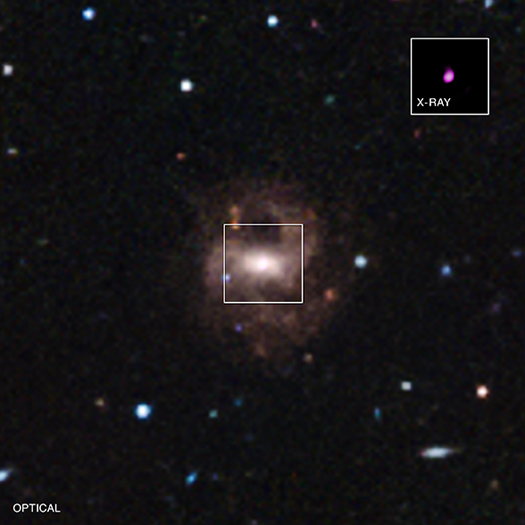For Release: August 11, 2015
NASA

Credit: X-ray: NASA/CXC/Univ of Michigan/V.F.Baldassare, et al; Optical: SDSS; Illustration: NASA/CXC/M.Weiss
Press Image and Caption
Astronomers using NASA's Chandra X-ray Observatory and the 6.5-meter Clay Telescope in Chile have identified the smallest supermassive black hole ever detected in the center of a galaxy. This oxymoronic object could provide clues to how larger black holes formed along with their host galaxies 13 billion years or more in the past.
Astronomers estimate this supermassive black hole is about 50,000 times the mass of the sun. This is less than half the mass of the previous smallest black hole at the center of a galaxy.
"It might sound contradictory, but finding such a small, large black hole is very important," said Vivienne Baldassare of the University of Michigan in Ann Arbor, first author of a paper on these results published in The Astrophysical Journal Letters. "We can use observations of the lightest supermassive black holes to better understand how black holes of different sizes grow."
The tiny heavyweight black hole is in the center of a dwarf disk galaxy, called RGG 118, located about 340 million light years from Earth, and was originally discovered using the Sloan Digital Sky Survey.
Researchers estimated the mass of the black hole by studying the motion of cool gas near the center of the galaxy using visible light data from the Clay Telescope. They used the Chandra data to figure out the X-ray brightness of hot gas swirling toward the black hole. They found the outward push of radiation pressure of this hot gas is about 1 percent of the black hole’s inward pull of gravity, matching the properties of other supermassive black holes.
Previously, scientists had noted a relationship between the mass of supermassive black holes and the range of velocities of stars in the center of their host galaxy. This relationship also holds for RGG 118 and its black hole.
"We found this little supermassive black hole behaves very much like its bigger, and in some cases much bigger, cousins," said co-author Amy Reines of the University of Michigan. "This tells us black holes grow in a similar way no matter what their size."
The black hole in RGG 118 is nearly 100 times less massive than the supermassive black hole found in the center of the Milky Way. It’s also about 200,000 times less massive than the heaviest black holes found in the centers of other galaxies.
Astronomers are trying to understand the formation of billion-solar-mass black holes from less than a billion years after the big bang, but many are undetectable with current technology. The black hole in RGG 118 gives astronomers an opportunity to study a nearby small supermassive black hole.
Astronomers think supermassive black holes may form when a large cloud of gas, with a mass of about 10,000 to 100,000 times that of the sun, collapses into a black hole. Many of these black hole seeds then merge to form much larger supermassive black holes. Alternately, a supermassive black hole seed could come from a giant star, about 100 times the sun’s mass, that ultimately forms into a black hole after it runs out of fuel and collapses.
"We have two main ideas for how these supermassive black holes are born," said Elena Gallo of the University of Michigan. "This black hole in RGG 118 is serving as a proxy for those in the very early universe and ultimately may help us decide which of the two is right."
Researchers will continue to look for other supermassive black holes that are comparable in size or even smaller than the one in RGG 118 to help decide which of the models is more accurate and refine their understanding of how these objects grow.
A preprint of these results is available online. The other co-author of the paper is Jenny Greene, from Princeton University in Princeton, New Jersey. NASA's Marshall Space Flight Center in Huntsville, Alabama, manages the Chandra program for NASA's Science Mission Directorate in Washington. The Smithsonian Astrophysical Observatory in Cambridge, Massachusetts, manages Chandra's science and flight operations.
An interactive image, a podcast, and a video about the findings are available at:http://chandra.si.edu
For more Chandra images, multimedia and related materials, visit:
http://www.nasa.gov/chandra
Media contacts:
Felicia Chou
Headquarters, Washington
202-358-0257
felicia.chou@nasa.gov
Megan Watzke
Chandra X-ray Center, Cambridge, Mass.
617-496-7998
mwatzke@cfa.harvard.edu



Visitor Comments (5)
A black hole should measure the sq root of the diameter of a galaxy. In a supernova explosion its size is reduced to the sq root of its original diameter. This gives a value of .001. This means that only .001 of the total mass of a galaxy is required to fuel the atomic energy required for reproduction. Take a galaxy of 200b stars will require 2b neutron stars in a black hole to re-produce a galaxy. If this is so we should find bumps in the background static every 200 years.
Posted by graham harris on Monday, 01.25.16 @ 16:56pm
Beautiful.
Posted by lee michael brown on Wednesday, 10.7.15 @ 05:36am
This site was really helpful for my 9th grade science project. It really did have a lot of information. I will defiantly use this site in the future.
Posted by nathan hollar on Wednesday, 09.23.15 @ 11:35am
Super interesting, Congratulations.
Dr.Amalia KOkkinou
Posted by Dr.AMALIA KOKKINOU on Friday, 08.21.15 @ 06:08am
Awesome Literally, as our technology improves it's fascinating to observe the opinions theories of our scientists change to understand our universe.
Posted by ben on Tuesday, 08.11.15 @ 16:24pm